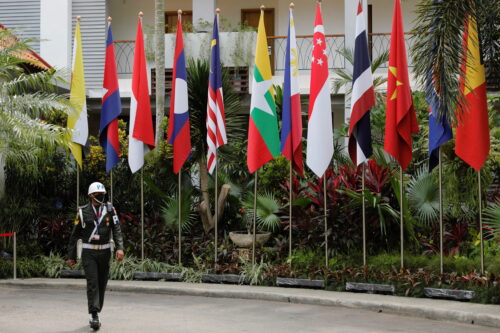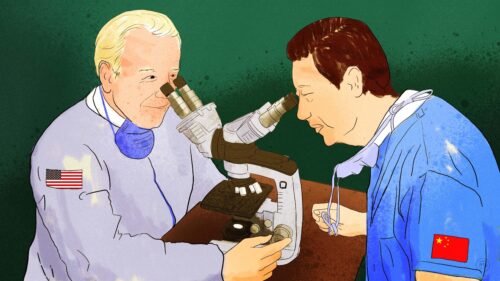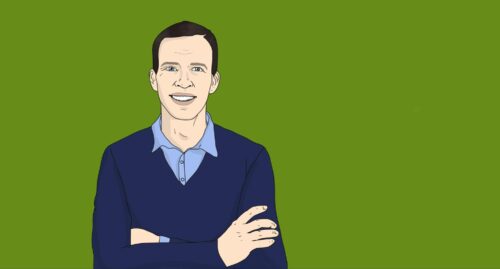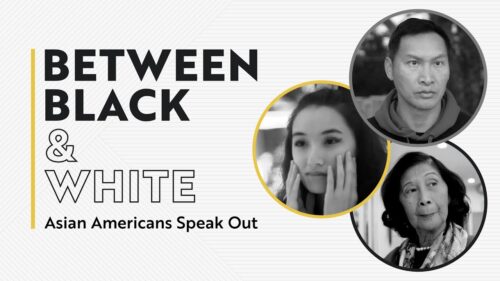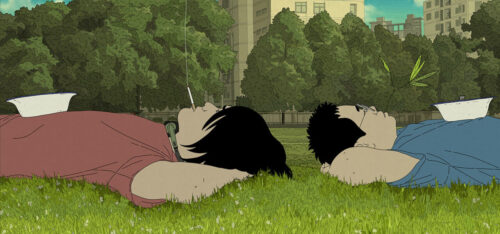For science, or the ‘motherland’? The dilemma facing China’s brightest minds
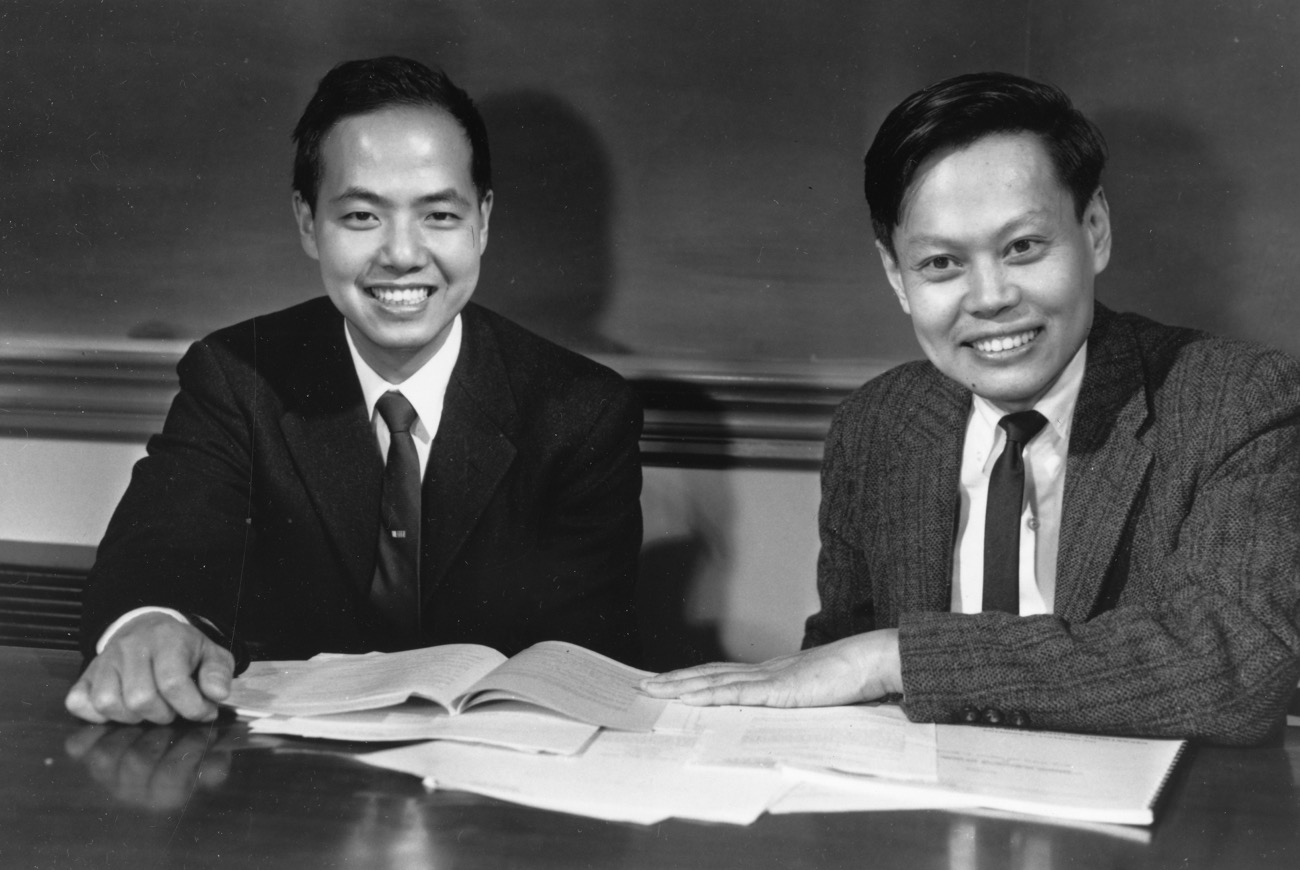
Pictured: Tsung-Dao Lee (left) and Chen Ning Yang (right)
The fathers of modern Chinese physics survived idealism and endured persecution.
They’re exalted now, but at what cost?
It was a chilly November day in 2007. The colloquium was scheduled to start at 4 in the afternoon, but hours earlier, the main auditorium at the University of Science and Technology of China (USTC) was already packed. Students without a seat sat on the steps and squeezed into the corridors. More huddled by the entrance, pouncing for an empty spot.
The celebrity speaker was Chen-Ning Yang (杨振宁 Yáng Zhènníng). The theoretical physicist and his collaborator Tsung-Dao Lee (李政道 Lǐ Zhèngdào) were the first people of Chinese ethnicity to win the Nobel prize in 1957. Though both had left China before the Communist government took power and conducted their award-winning work in the United States, Yang and Lee are venerated in the country of their birth as symbols of Chinese scientific prowess. Juniors at USTC, my roommates and I had waited outside after a quick lunch at noon, and could enjoy our hard-earned seats in eager anticipation.
We cheered as the 85-year-old took the stage. Yang spoke in English, and delivered a lecture on parity violation, his Nobel-winning work that proved the universe’s reflection in the mirror behaves differently from our expectations. The language barrier and specialized content did little to curb our excitement. We were finally witnessing one of our childhood science heroes in person.
I felt a particular affinity with Yang. We were both born and raised in Hefei, where USTC is located. In the early 1990s, the university erected a bronze statue of the scientist in front of its main teaching building. As a child, I spent countless hours playing by its feet, the metal surface giving shape to the stories I heard of Yang’s life and work. Little did I know at the time, our academic paths would cross twice on both sides of the Pacific. Yang studied briefly at my high school in Hefei in 1937, before the escalating Japanese invasion forced him and his family across China in search for safety. They finally settled in Kunming on China’s southwestern corner, where Yang’s father taught math at the National Southwestern Associated University (NSAU), and Yang later enrolled to study physics.
I received my doctorate in physics from the University of Chicago in 2015, the same school and program Yang graduated from 67 years prior. That same year, 2015, Yang relinquished the U.S. citizenship he obtained in 1964, and later became a citizen of the People’s Republic of China, returning to the land he grew up in but also to a state that he had not previously been a subject of. The Chinese Academy of Sciences had to make up special rules to transfer Yang’s membership from foreign to domestic, the first time such a change had occurred. “My late father’s blood runs in my veins. Chinese culture runs in my veins,” Yang explained to Chinese state media on this “no easy decision” of his.
I continue to live and work in the U.S. as a particle physicist. My experiment has thousands of scientists from dozens of countries in its collaboration, the results from which belong to no single state. For the past few years, I have watched with increasing alarm the deteriorating political climates in both my birth country and my adopted home. The Trump administration has deployed discriminatory policies and rhetoric toward women, immigrants, and people of color, all of which I am, and is increasingly suspicious of scientists of Chinese origin, citing concerns of national security and industrial espionage. On the other side of the Pacific, China under Xi Jinping descends further into the abyss of dictatorship and oppression, in the meantime flexing its techno-nationalistic muscle and advocating “civil-military fusion.”
Part of China’s strategy to become a science and technology superpower is aggressive pursuit of foreign-trained talent. The top of the homepage for the government’s flagship talent recruitment program reads in red, bold Chinese characters: “The motherland needs you. The motherland welcomes you. The motherland places her hope in you.”
The sentences do not begin with “China.” It’s “the motherland.” The Chinese government sees itself as not just ruling over a territory but in ownership of a people, whose basic rights it routinely denies. When Chinese scientists cross water, where is their motherland, and who are their people?
~
One of Yang’s best friends since adolescence was Dèng Jiàxiān 邓稼先. Two years Yang’s junior, Deng also majored in physics at NSAU. Among their professors was Wu Ta-You (吴大猷 Wú Dàyóu), who supervised Yang’s undergraduate thesis work. A native of Guangzhou, then known as Canton, Wu received his Ph.D. in physics from the University of Michigan and returned to China in 1934 before the war with Japan broke out. In the mid-1940s, all three left China for the U.S. to further their scientific work. Their fates would diverge in the whirlwinds of war and geopolitics, as physical and ideological borders divided the trio for decades to come. The story of Wu, Yang, and Deng is an epic saga of Chinese scientists’ search of national identity, political allegiance, and a higher purpose for science.
After the nuclear blasts over Hiroshima and Nagasaki in the summer of 1945 that brought the Japanese government to surrender, Chiang Kai-shek (蒋介石 Jiǎng Jièshí), leader of the Nationalist government in China, recognized the power of the new weapon and consulted Wu, one of leading physicists in the country. Wu told the Generalissimo that the key to a nuclear arsenal was not funding or lab space, but well-trained talent. At Wu’s suggestion, a small group of Chinese students were selected for postgraduate studies in the U.S. The physics candidates, handpicked by Wu, were Tsung-Dao Lee and Zhū Guāngyà 朱光亚.
Yang had also obtained a scholarship for the U.S. from the Boxer Indemnity. Both he and Lee came to the University of Chicago, where the first controlled, self-sustained nuclear chain reaction was achieved by Enrico Fermi and his team a few years earlier. Zhu went to Wu’s alma mater, the University of Michigan, where Wu also headed as a visiting professor. A couple years later, Deng joined them for his doctorate at Purdue University. Since the West Lafayette campus was only a few hours away, Deng shared a room on the south side of Chicago with Yang. The two were as close as brothers.
Nuclear weapons technology was a military secret closed off to foreigners. Instead of learning how to build the bomb, as Chiang’s government had hoped, the bright young minds from China pursued basic research in the booming field of fundamental physics. An ocean away, the civil war raged on in China, news of which weighed heavily on Yang and his cohort. Should they stay in the U.S. after graduation, which, despite its discriminatory policies toward Chinese immigrants, still offered much greater political stability, material comfort, and research opportunities? Or should they return to China, their battered, impoverished homeland that desperately needed scientific talent? Would it still be the same China if the government changed hands?
Yang shared his dilemma with his classmates from NSAU. Huáng Kūn 黄昆, then studying in the UK, responded with a long letter dated April 1, 1947. Huang acknowledged that intellectuals like them had little power to affect the fate of a nation, but even if returning to China meant “jumping into the pit of fire,” it was still worth it because “whether China has us makes a difference.”
“To successfully organize an independent center of physics (in China) is more important than winning a Nobel prize. Devotion to the cause must trump desire for individual achievement. I think you must agree with me!” Huang wrote at the end of the letter, both to persuade Yang and to affirm his own belief, “Whatever I preach implies that I struggle to adhere to it, so I must declare it loudly to strengthen myself.”
Deng agreed with Huang. In 1950, the 26-year-old boarded a ship back to China nine days after receiving his Ph.D. from Purdue. Huang returned to China the year after. Yang stayed in the U.S. for a postdoctoral position at the Institute for Advanced Study in Princeton. Wu moved to Canada to work at its National Research Council.
Deng and Huang would find themselves in good company. According to the Chinese Academy of Sciences, by 1956 more than 2,000 Chinese scientists, among an estimated 5,000 in the diaspora, had returned to their country of birth. Who could have predicted the persecutions they’d endure from the new government they had high hopes for?
The year 1956 was pivotal in the lives of all three characters in this story. Wu came to Taiwan per invitation of the Nationalist government in de facto exile, where he taught physics and advised on science policy. Yang published his paper on parity violation, co-authored with Lee, who also stayed in the U.S. Their theoretical prediction was confirmed by experiments the following year, garnering Yang and Lee the Nobel prize in physics. The People’s Daily, the Chinese Communist Party’s official mouthpiece, notably ran three articles in 1957 on Yang and Lee’s accomplishment, highlighting their Chinese origin by addressing them as “our country’s U.S.-based physicists Tsung-Dao Lee and Chen-Ning Yang.”
Deng joined the Chinese Communist Party in 1956. A leading figure in the newly established Chinese nuclear weapons program, Deng worked alongside Zhu Guangya, one of the two students Wu selected to study in the U.S. who returned to China in the same year as Deng. USTC, my undergraduate alma mater, was founded in 1958, counting among its central mission to train scientists for the country’s fledgling nuclear and space programs.
China successfully detonated its first atomic bomb in 1964, and its first hydrogen bomb in 1967. In middle school history class decades later, my classmates and I memorized these figures: “It took the Americans 13 years. It took the Soviets seven years. It took the Chinese two years and eight months.” They were the times between the A-bomb and the H-bomb for each country. The interval was the shortest in China, a clear indicator of the superiority of Chinese science, and by extension the Chinese state, so we were taught.
Though the civil war drained resources and derailed the plan, Chiang’s government never gave up its ambition for the bomb. In the 1960s, the project was back on the agenda in Taiwan, and Wu was again consulted as head of the science council. Unlike last time, Wu dissuaded Chiang, citing both practical and ethical concerns. A nuclear weapons program would be a huge financial burden for the government, and complicate its relationship with the U.S. The island lacked physical sites for testing, and a nuclear confrontation across the Taiwan Strait would be disastrous for both sides. Despite much displeasure from the military, Wu advocated for peaceful use of nuclear energy. Taiwan commissioned its first nuclear power plant in 1978. It would be another decade and a half before China did the same.
In a bitter twist of history, the Chinese scientists who built up the country’s nuclear defense found themselves defenseless when political winds turned and science was deemed heresy. When the Cultural Revolution started in 1966, Deng had a modicum of political protection compared with scientists in other disciplines, but as the country descended into abject chaos, even the top nuclear and space scientists were persecuted in fanatic political struggle. In 1971, Deng and his team were sent to the gulags in the northwestern Qinghai province, its neighboring dry lake of Lop Nur being home to China’s Los Alamos.
Yang became a naturalized U.S. citizen in 1964, citing convenience for international travel, and returned to China for the first time seven years after. At a time when Chinese scientists were demonized and tortured, Yang was treated as a foreign dignitary and met with the highest levels of the Communist government. The first person Yang asked to see was his old friend Deng, a request that freed Deng from the reeducation camps and plausibly saved his life. Among the millions who perished in the Cultural Revolution were China’s most distinguished intellectuals and their family members, including Wu’s undergraduate mentor Ráo Yùtài 饒毓泰 (one of China’s founders of modern physics, who committed suicide under persecution) and Deng’s older sister. Huang Kun, whose letter to Yang argued passionately why he must return to China to “make a difference,” endured hard labor but survived. Huang’s field of semiconductor technology was crippled from the beginning for political reasons, and is still playing catch-up in China today.
Deng continued working on the Chinese nuclear weapons program. The mission was so shrouded in secrecy that it was not until 1985 that the Chinese government publicly acknowledged Deng and his colleagues’ monumental work. “China’s Oppenheimer” died of cancer in 1986. Yang visited him in Beijing in his final days.
In 1987, the Taiwanese government lifted its 38-year-old martial law order, as well as the ban on travel to mainland China that had lasted the same duration. Five years later, an 85-year-old Wu went to Beijing for two international conferences on physics. It was the first time he returned to China in 46 years. Wu spent his final years teaching in Taiwan and working toward a book on the history of modern physics in China. “(The book) can be done on the mainland, but cannot be done in Taiwan alone,” he told his collaborator in China. “The father of Chinese physics” died in Taiwan in 2000 before the book was finished.
According to my Taiwanese colleagues, Wu was one of the most famous scientists in the Chinese-speaking world, his name appearing on buildings, in the media, and on the covers of textbooks. Growing up in China, I knew Wu was an esteemed physicist, but Deng and Yang were the household names, their life stories often compared against each other. Despite Yang’s well-recognized academic accomplishments, Deng was almost always portrayed as the superior scientist. Unlike Yang, Deng did not make significant contributions to advancing human understanding of nature, but Deng’s science served a higher purpose, as we were told, that in defense of one’s country and people. The Chinese government does not recognize dual nationality, and Yang’s U.S. citizenship was regarded as a betrayal to his blood by many in China, including Yang’s own father. “Till the day he died, my father never forgave me for giving up my Chinese citizenship,” Yang recalled in a 1983 book.
I arrived at the University of Chicago in the fall of 2009 for my Ph.D. in physics. On the academic family tree, Samuel K. Allison, whose lab Yang worked at briefly before switching to theoretical physics, would be my great-grandfather. The teaching building at the physics department has a wall adorned with portraits of the two dozen Nobel Laureates who once called the department home. There are Yang and Lee, as well as a long list of scientists who built the first bomb. A few among them, like Enrico Fermi and Eugene Wigner, and several more on the Manhattan Project, left Europe for the U.S. when the fascists came into power. They would find themselves not only living on the other side of the ocean, but also fighting on the opposite side of the war against their home governments.
One in particular, James Franck, resigned his position in Germany in protest of the Nazi government. He helped Jewish scientists in his native country find work overseas, and later headed the committee at the University of Chicago that issued the “Franck Report” in June 1945, arguing against the use of nuclear weapons against Japan. The U.S. government decided otherwise.
An earlier face on the wall is that of Werner Heisenberg. One of the founders of quantum mechanics was also the lead scientist in Nazi Germany’s nuclear weapons program. It is easy to criticize Heisenberg, but was it any more ethically justified to build the nuclear bomb for Mao than for Hitler?
Desiring atomic weapons since the late 1940s, Mao Zedong officially launched the program in 1955, during the First Taiwan Strait Crisis and under nuclear blackmail from the Eisenhower administration. Deng and his colleagues believed in using science to protect their homeland and its people, yet the government they built weapons for caused more Chinese deaths than any foreign invader in the country’s modern history. When a state could not guarantee its people basic human rights, should scientists have trusted the state with the most powerful weapons?
~
In our middle school Chinese class, we studied an eulogy by Yang in memory of his lifelong friend Deng. In hauntingly beautiful prose, Yang recalled the Tang Dynasty verse “Elegy for the Ancient Battlegrounds,” a classic piece of traditional Chinese literature he used to recite with Deng during their college days at NSAU. The lifeless deserts in northwestern China, where battles were fought between Han Chinese and steppe empires over millennia, became the research and test sites for the country’s nuclear weapons program, as well as its most notorious political prisons.
“I wonder how Jiaxian felt, when he buried his colleagues in the sand among the withering grass?” Yang asked, hinting at the enormous human sacrifice behind the Chinese bomb. Toward the end of the article, Yang suggested that if a film about Deng were ever to be made, an early 20th-century Chinese song, a favorite of Yang’s father’s, should serve as its theme music. The lyrics go like this: “The sons of China, the sons of China, they hold the sky aloft with a single hand. The rivers of the east surge on to the sea, the mighty mountains stand. How many valiant heroes through the ages gave up their lives in the barren borderland? The crimson never fades, from their blood spilled in the sand.”
As a woman, I do not appreciate the overtly masculine tone. As a scientist, I will not use my work to kill for a state. As an immigrant, I do not believe in absolute ownership of a land. And yet, as a Chinese person rereading these words over a decade and half later from an ocean away, I find tears streaming down my face. I cry for my scientific forefathers, the country they died for, and the state that did not deserve them.
Yangyang Cheng and the Science and China Column will return on the final Wednesday of every month.
